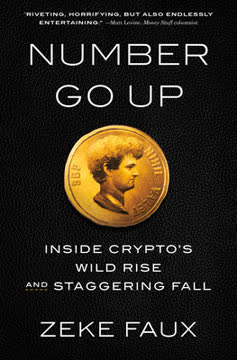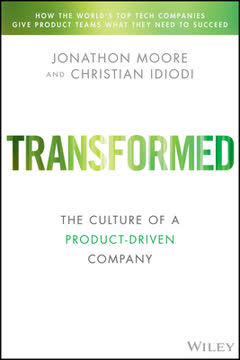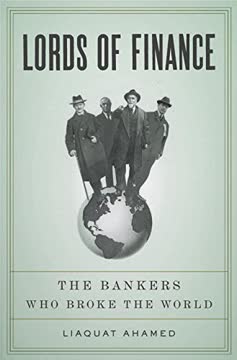Key Takeaways
1. Money is a shared fiction, not a cold mathematical reality
Money is a made-up thing, a shared fiction. Money is fundamentally, unalterably social.
Social construct: Money only has value because we collectively agree it does. It's not inherently valuable like food or shelter. This shared belief allows us to use money as a medium of exchange, store of value, and unit of account.
Historical evolution: Money has taken many forms throughout history, from cowrie shells and metal coins to paper notes and digital currencies. Each transition required a shift in collective thinking about what constitutes "money."
Trust is key: The effectiveness of money depends on trust in the issuing authority (e.g., government, central bank) and the broader economic system. When trust erodes, as during hyperinflation or financial crises, money can quickly lose its perceived value.
2. The origin of money is messy, bloody, and intertwined with human relationships
Marriage and murder are part of it. So is the invention of writing.
Beyond barter: The conventional story of money emerging from barter is largely myth. In reality, money grew out of complex social relationships, ritual obligations, and systems of credit and debt.
Early forms:
- Gift economies: Societies built on reciprocal gift-giving and obligations
- Tally sticks: Recording debts through notches on wooden sticks
- Temple economies: Religious institutions managing economic activity
Writing and accounting: The earliest forms of writing were developed to keep track of economic transactions, debts, and inventories. This demonstrates the deep connection between money, record-keeping, and the development of civilization.
3. Paper money revolutionized economies but faced resistance and setbacks
People prostituted the concept by putting garbage in the funds and reaching for yield.
Chinese innovation: Paper money was first developed in China, allowing for easier trade and economic expansion. However, it also led to periods of hyperinflation when governments printed too much.
European adoption: Paper money faced skepticism in Europe but gradually gained acceptance:
- Goldsmiths' receipts evolving into banknotes
- Creation of central banks to manage paper currency
- Struggles with maintaining public trust and preventing forgery
Boom and bust cycles: The ability to create money more easily through paper currency led to economic booms but also catastrophic busts, such as the Mississippi Bubble in France.
4. The gold standard's rigidity contributed to economic disasters
The gold standard locked countries in a terrible economic cycle. Breaking the link to gold broke the cycle.
Perceived stability: The gold standard was seen as providing monetary stability and discipline against government overspending. Countries fixed their currency's value to a specific amount of gold.
Deflationary pressures: During economic downturns, the gold standard prevented countries from expanding their money supply to stimulate growth, often worsening depressions.
Great Depression catalyst: The gold standard's constraints severely limited policymakers' ability to respond to the 1929 crash, deepening and prolonging the Great Depression. Countries that abandoned the gold standard earlier recovered faster.
5. Central banks emerged as crucial but controversial economic stabilizers
The essence of finance is time travel. Saving is about moving resources from the present into the future; financing is about moving resources from the future back into the present.
Evolution of role:
- From private banks serving governments to public institutions managing monetary policy
- Lenders of last resort during financial crises
- Controllers of money supply and interest rates
Balancing act: Central banks must navigate competing pressures:
- Maintaining price stability vs. promoting economic growth
- Independence from political interference vs. accountability to the public
- National interests vs. international cooperation
Criticisms: Central banks face accusations of:
- Enabling government overspending
- Favoring financial elites over ordinary citizens
- Creating boom-bust cycles through monetary policy
6. Technological advances created new forms of money and financial instruments
Shadow banking, and the shadow money it created, managed to get all of the safety net, after going decades without paying any of the cost. Shadow money was now real money.
Electronic payments: The rise of credit cards, online banking, and mobile payments has dramatically changed how we use and think about money.
Financial innovation:
- Money market funds: Blurring the line between savings and investments
- Derivatives: Complex financial instruments based on underlying assets
- Securitization: Bundling and reselling loans as tradable securities
Shadow banking: Non-bank financial institutions began performing bank-like functions without the same regulations, contributing to the 2008 financial crisis.
7. Bitcoin and cryptocurrencies challenge traditional notions of money and banking
The point of bitcoin is that no one is in charge. (You could also say that everyone is in charge, but that amounts to the same thing.)
Decentralization: Bitcoin operates without a central authority, using blockchain technology to verify transactions and create new units.
Key features:
- Limited supply: Only 21 million bitcoins will ever exist
- Pseudonymity: Transactions are recorded publicly but without real-world identities
- Borderless: Can be sent anywhere in the world without intermediaries
Challenges:
- Price volatility makes it difficult to use as a stable currency
- Scalability issues limit transaction speed
- Energy consumption of mining raises environmental concerns
8. The future of money may involve the disappearance of cash or radical banking reforms
Cash is dying. So here come Bitbux, E-Cash, Netchex, Cybercash, Netbills and Digicash, through the Patent and Trademark Office and into the marketplace.
Cashless society: Many countries are moving towards digital payments, with some (like Sweden) nearly eliminating cash use.
Potential reforms:
- Central bank digital currencies: Government-issued digital money
- Full-reserve banking: Separating money storage from lending functions
- Modern Monetary Theory: Rethinking government spending and monetary policy
Considerations:
- Privacy concerns in a fully digital money system
- Financial inclusion for the unbanked population
- Balancing innovation with financial stability and consumer protection
Last updated:
FAQ
What's "Money: The True Story of a Made-Up Thing" about?
- Exploration of Money's Nature: The book delves into the concept of money as a social construct, a shared fiction that has evolved over time.
- Historical Perspective: It traces the history of money from ancient barter systems to modern digital currencies, highlighting key transformations.
- Economic and Social Impact: The narrative examines how money has influenced economies, societies, and individual lives throughout history.
- Author's Journey: Jacob Goldstein shares his personal journey of understanding money, inspired by his experiences as a journalist and conversations with experts.
Why should I read "Money: The True Story of a Made-Up Thing"?
- Comprehensive Overview: The book provides a thorough understanding of the evolution of money, making it accessible to readers with varying levels of economic knowledge.
- Engaging Storytelling: Goldstein uses anecdotes and historical stories to make complex economic concepts relatable and interesting.
- Relevance to Modern Times: It connects historical developments to current financial systems, offering insights into contemporary economic issues.
- Thought-Provoking Ideas: The book challenges readers to rethink their perceptions of money and its role in society.
What are the key takeaways of "Money: The True Story of a Made-Up Thing"?
- Money as a Social Construct: Money is not a fixed entity but a shared belief that has changed over time based on societal needs and technological advancements.
- Historical Evolution: From barter to digital currencies, money has undergone significant transformations that reflect broader economic and social changes.
- Role of Trust: Trust is fundamental to the functioning of money, whether in the form of coins, paper, or digital transactions.
- Future of Money: The book suggests that money will continue to evolve, influenced by technological innovations and changing societal values.
How does Jacob Goldstein define money in "Money: The True Story of a Made-Up Thing"?
- Shared Fiction: Goldstein describes money as a shared fiction, a concept that exists because people collectively agree on its value.
- Social and Economic Tool: Money is a tool that facilitates trade, investment, and economic growth, but it is also deeply intertwined with social structures.
- Dynamic and Evolving: Money is not static; it has evolved from physical objects like cowrie shells to digital currencies, adapting to the needs of society.
- Trust-Based System: The value and functionality of money rely heavily on trust among individuals, institutions, and governments.
What are the best quotes from "Money: The True Story of a Made-Up Thing" and what do they mean?
- "Money is fiction": This quote encapsulates the idea that money's value is based on collective belief rather than intrinsic worth.
- "The essence of finance is time travel": This highlights how financial systems allow for the movement of resources across time, enabling investment and growth.
- "Money is fundamentally, unalterably social": It emphasizes that money is deeply connected to human relationships and societal structures.
- "Economic growth and technological change aren’t guaranteed to continue forever": This serves as a cautionary reminder that economic progress is not inevitable and requires careful management.
How does "Money: The True Story of a Made-Up Thing" explain the evolution of money?
- From Barter to Coins: The book starts with the transition from barter systems to the use of coins, which standardized trade and value.
- Introduction of Paper Money: It covers the invention of paper money in China and its eventual adoption in Europe, revolutionizing trade and finance.
- Rise of Banking Systems: The development of banks and the creation of credit systems are explored as pivotal moments in monetary history.
- Digital and Cryptocurrencies: The narrative concludes with the emergence of digital currencies and blockchain technology, highlighting ongoing changes in how money is perceived and used.
What role does trust play in the concept of money according to Jacob Goldstein?
- Foundation of Value: Trust is the foundation upon which the value of money is built; without it, money would lose its meaning and function.
- Facilitates Transactions: Trust allows people to engage in transactions with confidence, knowing that money will be accepted and honored.
- Institutional Trust: Trust in financial institutions and governments is crucial for maintaining stable monetary systems and preventing crises.
- Challenges in Digital Age: The book discusses how trust is being redefined in the digital age, with cryptocurrencies challenging traditional trust-based systems.
How does "Money: The True Story of a Made-Up Thing" address the future of money?
- Technological Influence: The book suggests that technology will continue to shape the future of money, with digital currencies and blockchain playing significant roles.
- Potential for Change: It highlights the potential for radical changes in monetary systems, driven by innovations and shifts in societal values.
- Challenges Ahead: The narrative acknowledges challenges such as privacy concerns, regulatory issues, and the need for new forms of trust.
- Uncertain Trajectory: While the future of money is uncertain, the book emphasizes the importance of understanding its history to navigate upcoming changes.
What historical examples does Jacob Goldstein use to illustrate the evolution of money?
- Mademoiselle Zélie's Concert: An anecdote about a French singer paid in pigs and coconuts illustrates the limitations of barter systems.
- Lydian Coins: The invention of coins in Lydia is used to show the transition from barter to standardized currency.
- Chinese Paper Money: The development of paper money in China highlights a major innovation in the history of money.
- John Law's System: The story of John Law's financial experiments in France serves as an example of early banking and monetary policy.
How does "Money: The True Story of a Made-Up Thing" connect historical monetary systems to modern financial issues?
- Lessons from the Past: The book draws parallels between historical monetary crises and contemporary financial challenges, emphasizing recurring themes.
- Evolution of Banking: It traces the development of banking systems from early goldsmiths to modern central banks, highlighting ongoing issues of trust and regulation.
- Impact of Technology: The narrative connects past innovations like paper money to current developments in digital currencies and blockchain technology.
- Societal Implications: By examining the social and economic impacts of historical monetary systems, the book provides insights into current debates about money and finance.
What insights does Jacob Goldstein offer about digital currencies in "Money: The True Story of a Made-Up Thing"?
- Potential for Disruption: Digital currencies have the potential to disrupt traditional financial systems by offering new forms of money and payment methods.
- Challenges of Adoption: The book discusses the challenges digital currencies face, including regulatory hurdles, security concerns, and the need for widespread acceptance.
- Trust and Decentralization: It explores how digital currencies aim to create trust through decentralized systems, reducing reliance on traditional financial institutions.
- Future Prospects: While acknowledging uncertainties, the book suggests that digital currencies could play a significant role in the future of money, reshaping how transactions are conducted.
How does "Money: The True Story of a Made-Up Thing" challenge traditional views of money?
- Questioning Intrinsic Value: The book challenges the notion that money has intrinsic value, emphasizing its nature as a social construct.
- Rethinking Stability: It questions the stability of traditional monetary systems, highlighting historical instances of failure and crisis.
- Embracing Change: The narrative encourages readers to embrace change and innovation in monetary systems, rather than clinging to outdated models.
- Broader Perspective: By providing a historical and global perspective, the book invites readers to reconsider their assumptions about what money is and how it should function.
Review Summary
Money: The True Story of a Made-Up Thing is praised as an engaging, accessible history of money and finance. Readers appreciate Goldstein's conversational style and ability to explain complex concepts. The book covers topics from ancient currency to modern cryptocurrencies, offering insights into monetary policy and economic systems. While some find it lacks depth, most enjoy its entertaining approach and historical anecdotes. Critics note occasional oversimplification and bias, but overall, readers recommend it as an informative introduction to the subject, particularly for those new to economics.
Similar Books










Download PDF
Download EPUB
.epub digital book format is ideal for reading ebooks on phones, tablets, and e-readers.




